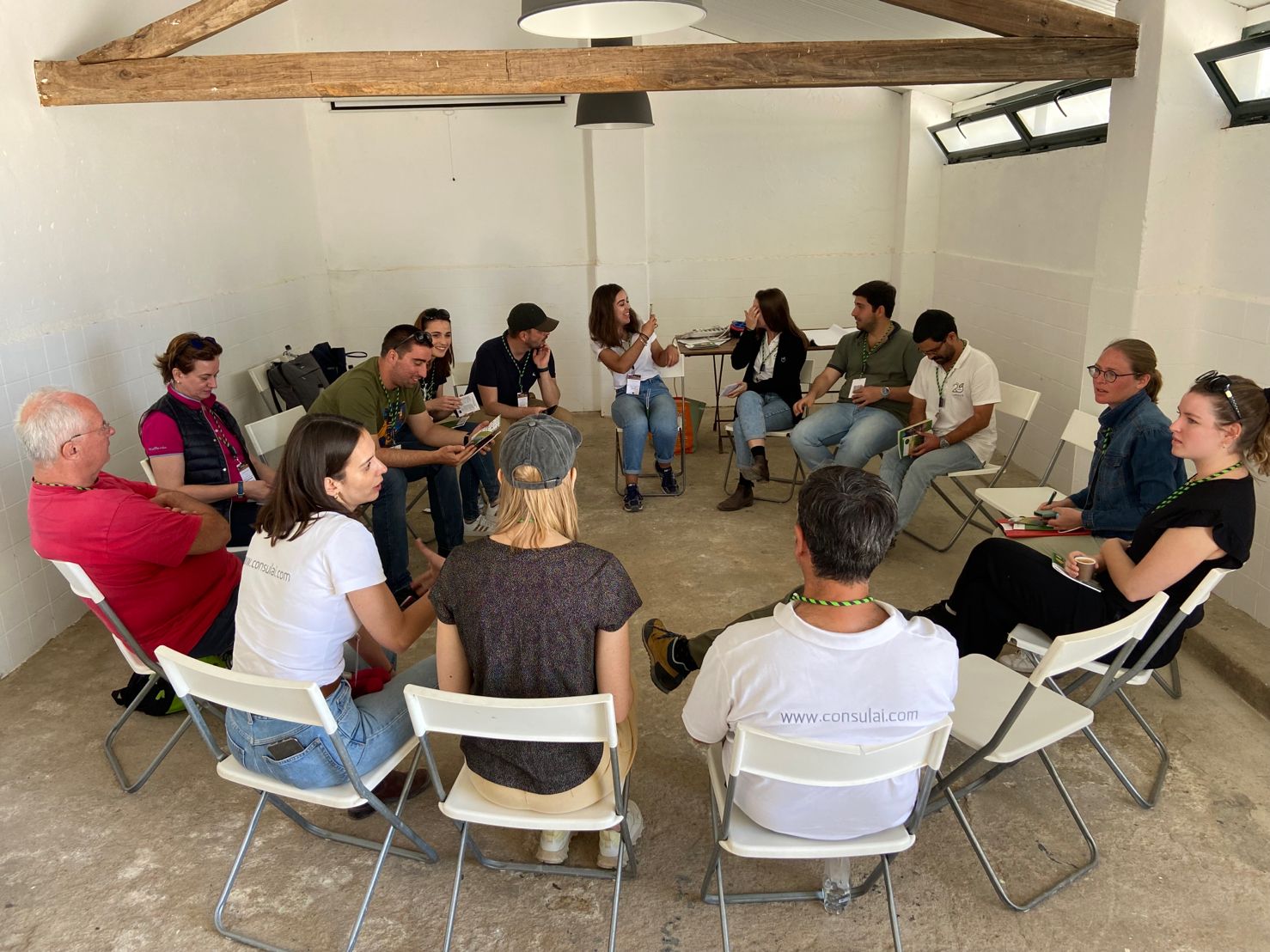Balandžio 19–21 dienomis grupė i2connect stažuotojų, sėkmingai baigusių interaktyvių inovacijų bendro kūrimo metodų mokymus, išvyko į Portugaliją, kad sužinotų daugiau apie Portugalijos žemės ūkį ir pritaikytų metodus realiame gyvenime, analizuodami Inovacijų spiralė, kuri paskatino sukurti projektą „Segunda Via – ekologinis žemės ūkio intensyvinimas“. Šiuo projektu siekiama sukurti modernų žemės ūkio valdymo modelį, derantį žemės ūkio produkcijos pelningumą su ekologinių buveinių išsaugojimo ir atkūrimo praktika.. Aplinkai atsakingo ūkio modelio kūrimas, tuo pačiu pasinaudojant jos pagrindu egzistuojančiu didžiuliu gamtos kapitalu, kurią galima plačiai atkartoti savo regione (Težo upės apylinkes) ir visoje šalyje. Projekto darbo grupėje dirba ūkininkas, fakultetas (Lisabonos universiteto mokslų fakultetas), du viešieji subjektai (EDIA ir Aplinkos fondas), konsultavimo paslaugų įmonė ir mūsų i2connect partnerinė organizacija (konsulatas). CONSULAI buvo įkurtas kovo mėnesį 2001. Nuo tada, ji tapo didžiausia konsultavimo įmone žemės ūkio verslo sektoriuje Portugalijoje, savo veiklą grindžia ilgalaikiais santykiais su klientais, reaguodamas į jų poreikius, skatinti jų konkurencingumą rinkoje, savo gaminių kokybę ir ekonominius rezultatus. Vidutinis žemės ūkio naudmenų plotas ūkyje Portugalijoje yra 14 ha ir daugiausia gaminamos produkcijos yra:
- Alyvuogės alyvuogių aliejui
- Vynuogės vynui
- Grūdai (kukurūzai, avižos, kviečiai, ryžių,…)
- Riešutai (migdolai, graikiniai riešutai, ir kaštonai)
- Citrusiniai ir kiti švieži vaisiai (apelsinai, obuoliai, kriaušės, vyšnios)
- Daržovės pramonei ir šviežios daržovės (bulvė, pomidoras)
Sužinokite daugiau apie Portugalijos žemės ūkį čia! Portugalija yra viena didžiausių kamštienos gamintojų pasaulyje ir dalyviai turėjo galimybę aplankyti 550 ha ūkį. 30 km nuo Lisabonos, kur savininkas paįvairino savo ūkininkavimą. Tai apima gyvulininkystę (kovojantys jaučiai, mėsinių galvijų, ir sportiniai žirgai), javų auginimas (miežių, kviečiai, kukurūzai, žirniai, saulėgrąžos), ir agromiškininkystė, kur auginami kamštiniai medžiai, tarp kurių ganosi karvės ir arkliai.
Kryžminio vizito dalyvė iš Latvijos Linda Šarķe-Fedjajeva dalijasi įspūdžiais: “Ūkininkas smalsus ir atviras, paklaustas, kaip jis žino, kad jo eksperimentai bus sėkmingi, jis juokiasi, jei to neišbandysi, niekada nesužinosite rezultato. Jo aistra – naujos technologijos, jo iššūkis – palikti žemę ir ūkį savo vaikams geresnės būklės, nei gavo iš tėvo. Savo ūkyje jis įdiegė daugybę biologinės įvairovės priemonių – jis pasėjo gėlių juosteles aplink laukus, kad pritrauktų apdulkintojus, jis įstatė šikšnosparnių ir paukščių narvus į medžius, kad padidintų kelių rūšių vabzdžių natūralių priešų skaičių, jis yra tiksliojo ūkininkavimo gerbėjas ir naudoja dronus laukams stebėti. Jis naudoja atvirus palydovinius duomenis savo laukų būklei analizuoti. Įdomiausia tai, kad jam priklauso tik dalis jam reikalingos technikos, likusią dalį perka kaip paslaugą. Tai yra ekonomiškiau nei išlaikyti visą technikos parką.
O dabar šiek tiek apie kamštmedžius, kuri man yra visiška naujovė! Ar žinojote, kad reikia 40 metų, kad gautų pirmąjį įpusėjusį vertingą kamštienos derlių?! Kamštienos medis auga lėtai, kaip ąžuolas. Kamštienos sluoksnis atsinaujina ir gali būti pašalintas tik kas devynerius metus. Šio vizito metu mus lydėjęs miškininkystės patarėjas patikino, kad medžiui nepakenks kamštienos sluoksnio pašalinimas.. Faktiškai, po to 40 augimo metų, galima gauti tik žemiausios kokybės kamštienos, kuri vis dar negamina kamštelių, kuriuos matome vyno buteliuose. „Derliaus nuėmimas’ kamštienos medžio priežiūra yra sudėtinga užduotis, reikalaujanti specifinių įgūdžių ir žinių. Mokyklose to nemoko ir yra amatas, kurį mokinys perima iš meistro tik darydamas. Reikia 2-3 žmonių dirbti vieną padorų medį (apie 300 metų amžiaus) ir jie atliktų darbą 2 valandų. Darbas gerai apmokamas, bet vis mažiau tai išmanančių meistrų. Deja, kamštienos medžių sodinimas taip pat gana nenuspėjamas. Prieš porą metų šeimininkas pasodino didelį jaunų medžių medyną, iš kurių tik keletas išgyveno. Įdomu, kamštienos derlių galima skinti tik esant pakankamai drėgmės dirvoje. Jei žemė sausa, kamštienos nuskinti beveik neįmanoma ir tam reikia laukti kitų metų.
Taip nuostabu, kad daugelis žmonių klausosi jo patirties ir vis mažiau bijo eksperimentuoti savo srityse!”
Ekologinio dėmesio sritys (EFA) yra kraštovaizdžio ypatybės, ar žalias (augmenija) arba mėlyna (vandens), kurios didina ir teikia ekologinę naudą, tiesiogiai arba netiesiogiai. Kiekviena savybė turi tam tikrą potencialų poveikį ekosistemų funkcijoms ir biologinei įvairovei, atsirandanti dėl jos pačios konfigūracijos ir savybių.
Be supratimo, kokį poveikį EFA daro ekosistemų funkcijoms ir biologinei įvairovei, svarbu suprasti EFA įtaką aplinkai. Faktiškai, EFA priežiūros ar įrengimo poveikį turi kitų gretimų struktūrų buvimas arba ryšys su jomis. Apskritai, individuali ekologiniu požiūriu svarbios teritorijos vertė didėja, kai šalia jos yra kitų EFA. Apsilankę galite sužinoti daugiau apie geriausios praktikos, skatinančios ekosistemų funkcijas ir biologinę įvairovę, nustatymą BPA.Eco projektas!





















